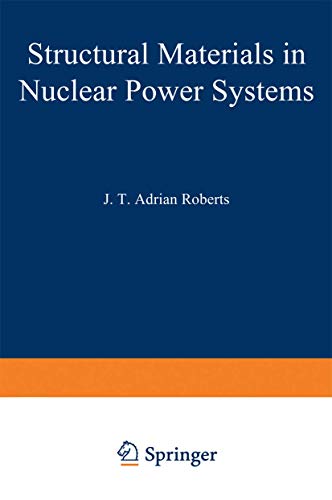Articoli correlati a Structural Materials in Nuclear Power Systems (Modern...

Le informazioni nella sezione "Riassunto" possono far riferimento a edizioni diverse di questo titolo.
Le informazioni nella sezione "Su questo libro" possono far riferimento a edizioni diverse di questo titolo.
- EditoreSpringer
- Data di pubblicazione2012
- ISBN 10 1468471961
- ISBN 13 9781468471960
- RilegaturaCopertina flessibile
- Numero di pagine500
Compra nuovo
Scopri di più su questo articolo
Spese di spedizione:
EUR 23,00
Da: Germania a: U.S.A.
I migliori risultati di ricerca su AbeBooks
Structural Materials in Nuclear Power Systems
Descrizione libro Taschenbuch. Condizione: Neu. This item is printed on demand - it takes 3-4 days longer - Neuware -In recent years the effort devoted to assuring both the safety and reliability of commercial nuclear fission power reactors has markedly increased. The incentives for performing this work are large since the resulting im provement in plant productivity translates into lower fuel costs and, more importantly, reduced reliance on imported oil. Reliability and availability of nuclear power plants, whether fission or fusion, demand that more attention be focused on the behavior of materials. Recent experiences with fission power indicate that the basic properties of materials, which categorize their reliable behavior under specified conditions, need reinforcement to assure trouble-free operation for the expected service life. The pursuit of additional information con tinues to demand a better understanding of some of the observed anom alous behavior, and of the margin of resistance of materials to unpre dictable service conditions. It is also apparent that, next to plasma heating and confinement, materials selection represents the most serious chal lenge to the introduction of fusion power. The recognition of the importance of materials performance to nu clear plant performance has sustained a multimillion dollar worldwide research and development effort that has yielded significant results, both in quantification of the performance limits of materials in current use and the development and qualification of new materials. Most of this infor mation appears in the open literature in the form of research reports, journal articles, and conference proceedings. 500 pp. Englisch. Codice articolo 9781468471960
Structural Materials in Nuclear Power Systems (Modern Analytical Chemistry) by ., . [Paperback ]
Descrizione libro Soft Cover. Condizione: new. Codice articolo 9781468471960
Structural Materials in Nuclear Power Systems (Modern Analytical Chemistry)
Descrizione libro Condizione: New. Codice articolo ABLIING23Mar2716030069504
Structural Materials in Nuclear Power Systems
Print on DemandDescrizione libro Condizione: New. PRINT ON DEMAND Book; New; Fast Shipping from the UK. No. book. Codice articolo ria9781468471960_lsuk
Structural Materials in Nuclear Power Systems
Descrizione libro Condizione: New. Codice articolo 4204693
Structural Materials in Nuclear Power Systems
Descrizione libro Taschenbuch. Condizione: Neu. Druck auf Anfrage Neuware - Printed after ordering - In recent years the effort devoted to assuring both the safety and reliability of commercial nuclear fission power reactors has markedly increased. The incentives for performing this work are large since the resulting im provement in plant productivity translates into lower fuel costs and, more importantly, reduced reliance on imported oil. Reliability and availability of nuclear power plants, whether fission or fusion, demand that more attention be focused on the behavior of materials. Recent experiences with fission power indicate that the basic properties of materials, which categorize their reliable behavior under specified conditions, need reinforcement to assure trouble-free operation for the expected service life. The pursuit of additional information con tinues to demand a better understanding of some of the observed anom alous behavior, and of the margin of resistance of materials to unpre dictable service conditions. It is also apparent that, next to plasma heating and confinement, materials selection represents the most serious chal lenge to the introduction of fusion power. The recognition of the importance of materials performance to nu clear plant performance has sustained a multimillion dollar worldwide research and development effort that has yielded significant results, both in quantification of the performance limits of materials in current use and the development and qualification of new materials. Most of this infor mation appears in the open literature in the form of research reports, journal articles, and conference proceedings. Codice articolo 9781468471960
Structural Materials in Nuclear Power Systems
Descrizione libro Paperback / softback. Condizione: New. This item is printed on demand. New copy - Usually dispatched within 5-9 working days. Codice articolo C9781468471960

